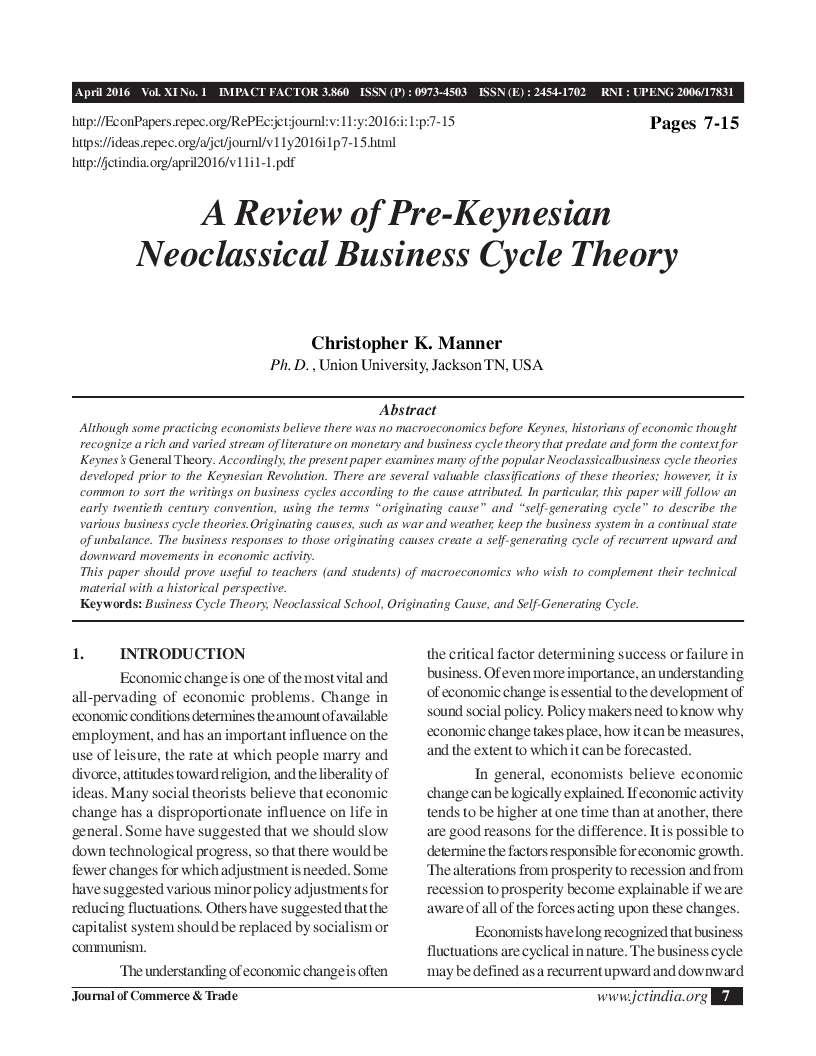A Review of Pre-Keynesian Neoclassical Business Cycle Theory
DOI:
https://doi.org/10.26703/jct.v11i1.223Keywords:
Business Cycle Theory, Neoclassical School, Originating Cause, Self- Generating CycleAbstract
Although some practicing economists believe there was no macroeconomics before Keynes, historians of economic thought recognize a rich and varied stream of literature on monetary and business cycle theory that predate and form the context for Keynes’s General Theory. Accordingly, the present paper examines many of the popular Neoclassicalbusiness cycle theories developed prior to the Keynesian Revolution. There are several valuable classifications of these theories; however, it is common to sort the writings on business cycles according to the cause attributed. In particular, this paper will follow an early twentieth century convention, using the terms “originating cause” and “self-generating cycle” to describe the various business cycle theories.Originating causes, such as war and weather, keep the business system in a continual state of unbalance. The business responses to those originating causes create a self-generating cycle of recurrent upward and downward movements in economic activity. This paper should prove useful to teachers (and students) of macroeconomics who wish to complement their technical material with a historical perspective.
Downloads
References
Adams, A.B. (1925). Economics and Business Cycles, McGraw-Hill Book Company, Inc., New york.
Adams, F.G. (1992) Lawrence Klein’s The Keynesian Revolution: 50 Years After. Philadelphia: Department of Economics, University of Pennsylvania.
Aftilion, A. (1927). The Theory of Economic Cycles Based on the Capitalistic Technique of Production. Review of Economic Statistics, 9, 165-170.
Bouniatian, M. (1928). The Theory of Economic Cycles Based on the Capitalistic Technique of Production. Review of Economic Statistics, 10, 67-79.
Bratt, E.C. (1937). Business Cycles and Forecasting, Business Publications, Inc. Chicago.
Clark, J.M. (1934). Strategic Factors in Business Cycles, National Bureau of Economic Research.
Dimand, R.W. (2003). Interwar Monetary and Business Cycle Theory: Macroeconomics Before Keynes. Research in the History of Economic Thought and Methodology, 21-A, 121-148.
England, M.T. (1915). Promotion as the Cause of Crisis. Journal of Economics, 29, 631-41.
Fisher, I. (1913). The Purchasing Power of Money, The Macmillan Company, New York.
Foster, W. T. &Catchings, W. (1925). Profits, Houghton, Mifflin Company, Boston, Pollak Foundation.
Hansen, A.H. (1921). Cycles of Prosperity and Depression in the United States, Great Britain, and Germany: A Study of Monthly Data, 1902-08, University of Wisconsin.
Hastings, H.B. (1923). Costs and Profits, Houghton, Mifflin Company, Boston, Pollak Foundation.
Hawtrey, R.G. (1913). Good and Bad Trade, Constable & Company, Ltd., London.
Hayek, F.A. (1932). Monetary Theory and the Trade Cycle, Harcourt, Brace & Company, New York.
Hexter, M.B. (1925). Social Consequences of the Business Cycle, Houghton, Mifflin Company, Boston.
Huntington, E. (1919). World-Power and Evolution, Yale University Press.
Jevons, H.S. (1910). The Sun’s Heat and Trade Activity, P.S. King & Son, London.
Jevons, W.S. (1884). Investigations in Currency and Finance, Macmillan & Company, Ltd., London.
Lederer, E. (1925). Konjunktur und krisen. Grundr. d. Sozialokonomik, 4, Tubingen, 354-413.
Mata, C.G. &Shaffner, F.I. (1934). Solar and Economic Relationships: A Preliminary Report. Quarterly Journal of Economics, 49, 1-51.
Mitchell, W.C. (1923). Report of a Dinner Meeting. Journal of the American Statistical Association, 18, 657-659.
Mitchell, W.C. (1927). Business Cycles, the Problem and its Setting. New York: National Bureau for Economic Research.
Moore, H.L. (1914). Economic Cycles: Their Law and Cause, TheMacmillan Company, New York.
Pigou A.C. (1927). Industrial Fluctuations, Macmillan & Company, New York.
Schluter, W.C. (1923). The Pre-War Business Cycle, 1907 to 1914, Columbia University Press.
Schumpeter, J.A. (1927). The Explanation of the Business Cycle. Economica, 7, 286-311.
Spiethoff, A. (1902). VorbemerkungenzueinerTheorie der Überproduktion, Schmollers JahrbuchfürGesetzgebung, Verwaltung und VolkswirtschaftimDeutschenReiche, 26, 721-59.
Tugan-Branovskij, M.I. (1894). Promyshlennyekrizisy vsovremennoiAnglii, ikhprichinyivliianienanarodnuiuzhizn’.St. Petersburg, RU: I.N. Skorokhodova. German Edition
Veblen, T. (1904). The Theory of Business Enterprise, Charles Scribner’s Sons, New York.
Working, H. (1928). Review of W. C. Mitchell’s Business Cycles. Journal of the American Statistical Association, 23, 89-94.

Downloads
Published
Issue
Section
License
Copyright (c) 2016 Christopher K. Manner

This work is licensed under a Creative Commons Attribution 4.0 International License.










